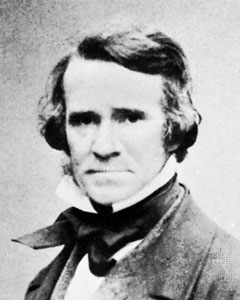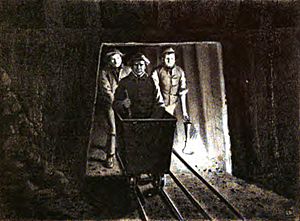John Hawkshaw facts for kids
Quick facts for kids
John Hawkshaw
|
|
|---|---|

John Hawkshaw
|
|
| Born | 9 April 1811 Leeds, Yorkshire
|
| Died | 2 June 1891 (aged 80) London
|
| Nationality | English |
| Occupation | Engineer |
| Engineering career | |
| Discipline | civil engineer |
| Institutions | Institution of Civil Engineers (president) |
| Projects | London Circle Line |
| Significant design | Suez Canal (inquiry) |
Sir John Hawkshaw (born April 9, 1811 – died June 2, 1891) was a famous English civil engineer. He designed many important structures like railways, canals, and tunnels. He was even the president of the Institution of Civil Engineers from 1862 to 1863. One of his most famous projects was the Severn Tunnel.
Contents
Early Life and First Jobs
John Hawkshaw was born in Leeds, England, in 1811. He went to Leeds Grammar School. He started working on railways and roads when he was very young, even before he turned 21!
At 21, he got a job in Venezuela. He worked for a company that was developing copper mines. They wanted to build a railway line to the coast. This would make it easier to transport copper than using the Aroa River. However, the climate there was too much for his health. He had to return to England in 1834.
Building a Career
Back in England, John Hawkshaw quickly found new work. He first worked at the Liverpool docks. Later, he became the main engineer for the Manchester, Bolton and Bury Canal Company. This company managed both canals and railways.
In 1845, he became the chief engineer for the Manchester and Leeds Railway. This company later became the Lancashire and Yorkshire Railway. He built many new railway lines for them.
Becoming a Consulting Engineer
In 1850, Hawkshaw moved to London. He started his own business as a consulting engineer. This meant other companies would hire him for his expert advice. His work was very varied, covering almost every type of engineering.
He continued to work with the Lancashire & Yorkshire Company until 1888. They asked for his advice on all their big engineering questions. In London, he designed the railways for Charing Cross and Cannon Street stations. He also built the two bridges that carried these railways over the Thames.
He was also the engineer for the East London railway. This line goes under the Thames through the famous Thames Tunnel. He also helped complete the London Underground's inner circle between Aldgate and Mansion House stations.
Railways Around the World
John Hawkshaw worked on many railway projects all over the world. He helped build railways in Germany, Russia, India, and Mauritius. He believed that railways could handle steeper slopes than other engineers thought possible.
He also disagreed with the "broad gauge" railway tracks used by the Great Western Railway. He thought having different track widths would cause problems in the future. He preferred all railways in a country to have the same track width.
Canals and Waterways
Canal building was another important part of his work. In 1862, he became the chief engineer for the Dutch North Sea Canal. This was a large ship-canal project.
He also played a key role in the Suez Canal project. At one point, the project was facing difficulties. The ruler of Egypt, the khedive, asked Hawkshaw for his opinion. Hawkshaw's report was very positive. This helped the project continue and eventually be completed.
He was part of an international group that looked at building a canal across Central America. He thought the Nicaragua route was the best option. He believed the Panama scheme would be too expensive.
Harbours and Docks
Sir John Hawkshaw also had a lot of experience building harbours and docks. Some of his projects included Holyhead Harbour, Penarth docks, and the Albert Dock at Hull. He also worked on the South Dock of the West India Docks in London.
He was also involved in river engineering, drainage, sewerage systems, and water supply projects. He designed the sewerage system for Brighton, England.
The Channel Tunnel and Severn Tunnel
From 1872, he was an engineer for the original Channel Tunnel Company. He had studied the idea of a tunnel under the Strait of Dover many years before. He believed it was possible to build it. However, he later decided that the tunnel would not be good for Great Britain. So, he stopped working on the project.
He was also a consulting engineer for the Severn Tunnel. This tunnel was one of the biggest and most challenging engineering projects of the 19th century. After a flood in the tunnel in 1879, he hired Thomas A. Walker to help finish the work.
He also designed the famous Puerto Madero, the port of Buenos Aires, Argentina. This project started in 1885 and was finished in 1898.
Family Life
In 1835, John Hawkshaw married Ann Jackson. They had six children together. Two of their children, Ada and Oliver, sadly died young. His son, John Clarke Hawkshaw, also became a civil engineer.
Sir John Hawkshaw passed away in London on June 2, 1891.
Honours and Awards
John Hawkshaw received many honours for his important work.
- He became a Fellow of the Royal Society in 1855.
- In 1875, he was elected a Fellow of the Royal Society of Edinburgh.
- He served as president of the Institution of Civil Engineers from 1861 to 1863.
- He was made a knight in 1873, earning the title "Sir."
- In 1880, he became an honorary member of the American Society of Civil Engineers.
Today, a pub inside Cannon Street station in London is named "The Sir John Hawkshaw" in his honour.


